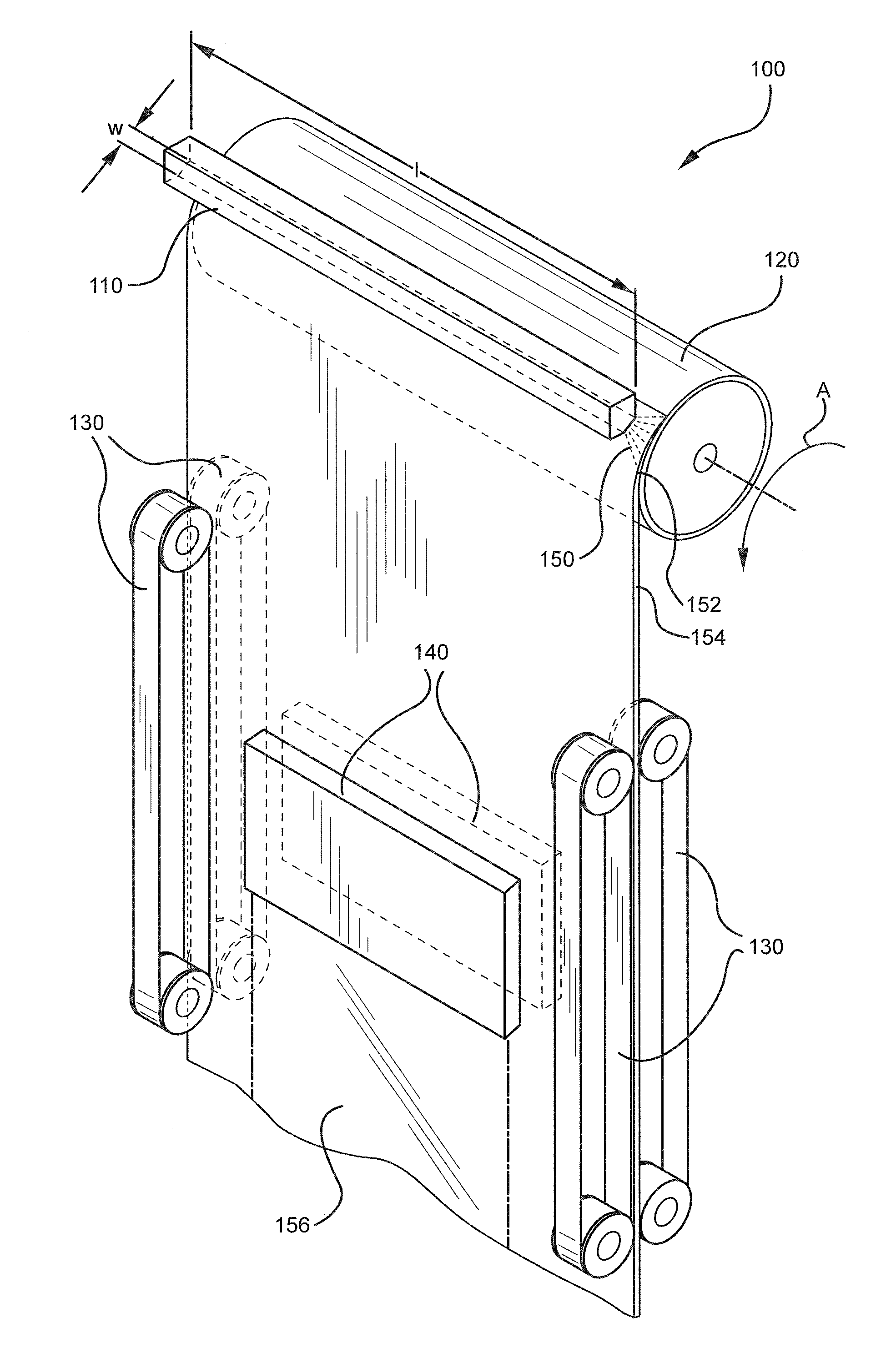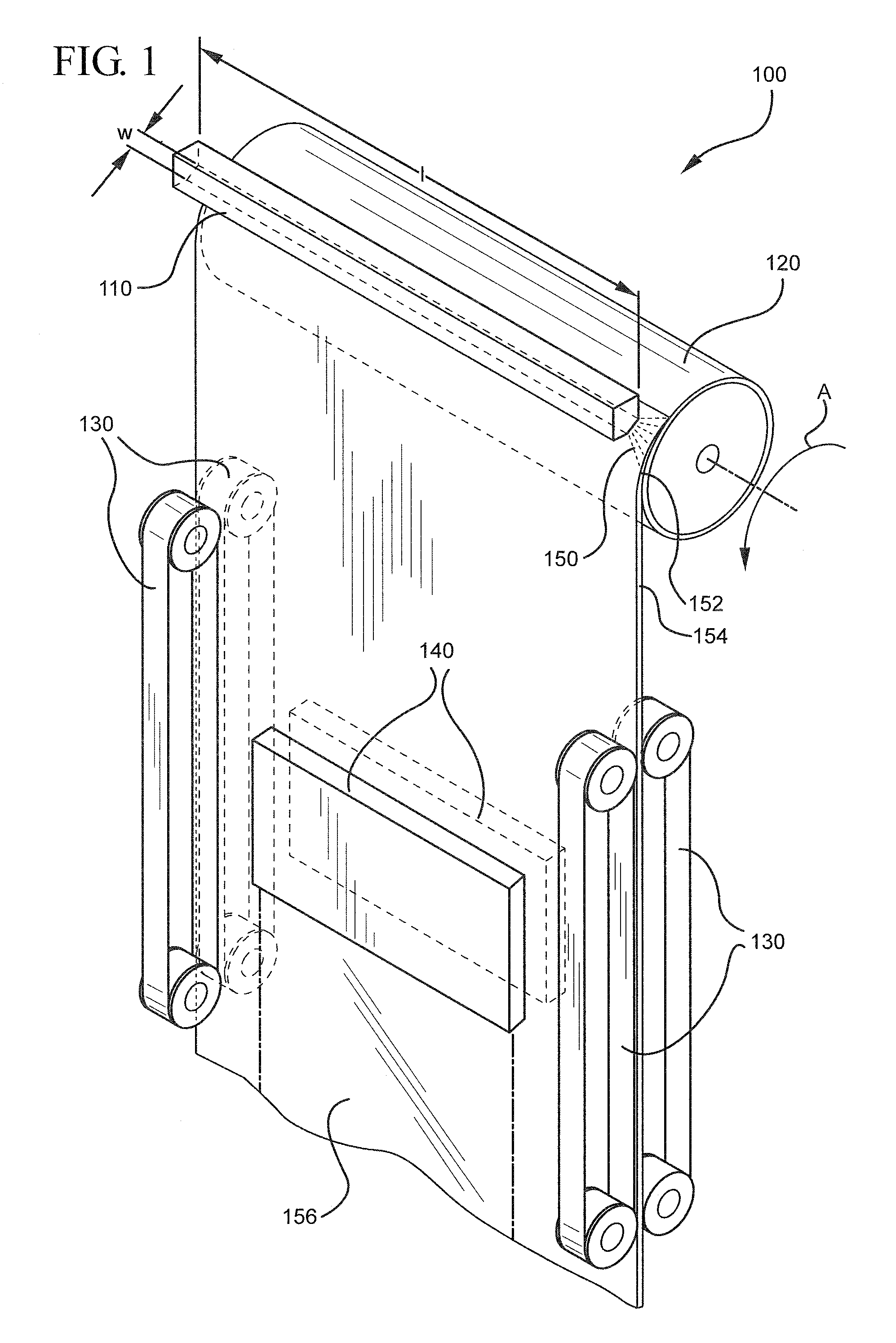Roll-to-roll glass material attributes and fingerprint
a technology of fingerprint and glass, applied in the field of glass sheets, can solve the problems of unsatisfactory surface quality, added expense, and unsatisfactory surface quality, and achieve the effect of high surface quality
- Summary
- Abstract
- Description
- Claims
- Application Information
AI Technical Summary
Benefits of technology
Problems solved by technology
Method used
Image
Examples
example 1
Fabrication of a Single-Layer Soot Sheet
[0072]A soot layer comprising 99+ mole % silica was produced using five linear burners. The five 2.5 cm wide burners were mounted adjacently in a burner array to produce a uniform, 12.5 cm wide soot stream. Each burner included 9 parallel rows of gas orifices. The gas orifices each measure 0.075 cm in diameter.
[0073]A precursor gas mixture comprising OMCTS (5 g / min) entrained in N2 (20 SLPM) was flowed through the centerline row of orifices. Oxygen gas was flowed through three adjacent rows of orifices on each side of the centerline row. The oxygen gas flow through the immediately adjacent rows was 5 SLPM, while the oxygen gas flow through the next pair of rows was 20 SLPM. The gas flow through the final (outside) orifice rows comprised a mixture of CH4 (12 SLPM) and O2 (10 SLPM).
[0074]The burners were positioned approximately 10 cm from the deposition surface of a cylindrical soot-receiving device. The soot-receiving device had a diameter of ...
example 2
Sintering of a Single-Layer Soot Sheet
[0076]A soot sheet as described above in Example 1 but having a thickness of about 400 microns was fabricated. The thickness was increased by decreasing the rotation speed of the soot-receiving device and increasing the OMCTS flow rate.
[0077]A soot sheet measuring approximately 1.2 m long and 7.6 cm wide was sintered by first gripping peripheral edges of the soot sheet between rollers that maintained contact along the length of the sample within a sintering zone, and then passing the soot sheet through a heat source that heated the soot sheet to approximately 1500° C. to form a densified, clear, sintered glass. The sintered glass had a final thickness of approximately 100 microns.
[0078]The sintered sheet having un-sintered peripheral edges was removed from the gripping rollers and the un-sintered edges were trimmed using a laser that was traversed at approximately 3 mm / s along the length of the sheet.
example 3
Effect of Process Conditions on Soot Sheet Thickness and Density
[0079]A designed experiment was conducted in which the (i) rotational velocity of the soot-receiving device, (ii) distance from the burner to the deposition surface, and (iii) 02 flow rate in the outermost burner columns (i.e., columns 1 and 9) were systemically varied. The effects of these variables on the thickness and density of the resulting soot sheet were measured and the data is shown in Table 2. Using the selected parameters, as seen in the tabulated data, a thickness of the soot sheet varies from about 250 to 700 microns, and a bulk density of the soot sheet varies from about 0.35 to 0.7 g / cm3. Generally, the soot sheet thickness and density increase with decreasing velocity of the soot-receiving device.
TABLE 2Effect of process conditions on soot sheet thickness and bulk densityBurner-DepositionSootBulk SootRunVelocitySurfaceO2ThicknessDensity#[mm / sec]Distance [mm][slpm][μm][g / cm3]1327.9263500.372227.9305000.40...
PUM
| Property | Measurement | Unit |
|---|---|---|
| thickness | aaaaa | aaaaa |
| surface roughness | aaaaa | aaaaa |
| thickness | aaaaa | aaaaa |
Abstract
Description
Claims
Application Information
 Login to View More
Login to View More - R&D
- Intellectual Property
- Life Sciences
- Materials
- Tech Scout
- Unparalleled Data Quality
- Higher Quality Content
- 60% Fewer Hallucinations
Browse by: Latest US Patents, China's latest patents, Technical Efficacy Thesaurus, Application Domain, Technology Topic, Popular Technical Reports.
© 2025 PatSnap. All rights reserved.Legal|Privacy policy|Modern Slavery Act Transparency Statement|Sitemap|About US| Contact US: help@patsnap.com



